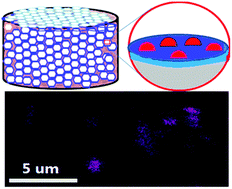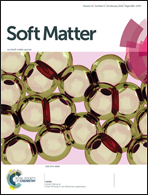Large-scale preparation of a 3D patchy surface with dissimilar dendritic amphiphiles†
Abstract
We show here the first example of the large-scale surface decoration of a macroscopic and porous monolith with dissimilar micropatches. Branched polyethylenimine (PEI) is alkylated with poly(propylene glycol) (PPG), leading to a reverse-micelle-like dendritic amphiphile of PEI@PPG. Peralkylation and partial quaternization of the residual amino groups of PEI@PPG produces a cationic dendritic amphiphile of PEI-N+@PPG. The two dendritic amphiphiles jointly stabilize a water-in-oil high-internal-phase emulsion to prepare open-cellular monoliths of macroscopic size, with the monolith pore surface dictated by the cationic and neutral dendritic amphiphiles. The amino groups of the neutral amphiphile are further derivatized into anionic dithiocarbamates. The resulting monolith, along with the dissimilar functional patches on the surface, simultaneously eliminates multiple anionic and cationic micropollutants from water to very low residues, and affords the pH-triggered sequential release. Our strategy of using dissimilar dendritic amphiphiles rather than block copolymers as surface building blocks can confer the resulting surface with robust and predesigned microenvironments besides the conventional coacervate structure, and thus can afford more functions.



 Please wait while we load your content...
Please wait while we load your content...